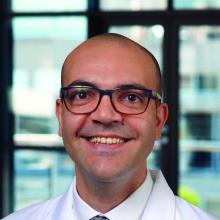Several emerging bronchoscopic treatments have the potential to improve the quality of life for patients with chronic obstructive pulmonary disease, an investigator reported at the annual meeting of the American College of Chest Physicians.
Targeted lung denervation is one promising novel therapeutic option that is safe and may improve clinical outcomes according to investigator Christian Ghattas, MD.
Data from an ongoing phase 3 randomized controlled trial may provide new information on the efficacy of targeted lung denervation in patients with chronic obstructive pulmonary disease (COPD), said Dr. Ghattas, assistant professor of medicine and associate program director for the interventional pulmonary fellowship at The Ohio State University Medical Center in Columbus.
“Outcome data of longer follow-up on previously treated patients will provide us with more information on the durability and the effect of this treatment,” Dr. Ghattas said in an online presentation at the CHEST meeting, which was held virtually this year.
Meanwhile, a few compelling bronchoscopic treatment modalities for patients with chronic bronchitis are in earlier stages of clinical development. “Larger randomized, controlled trials are ongoing to confirm the available data and to evaluate treatment durability,” said Dr. Ghattas.
Targeted lung denervation
The targeted lung denervation system under study (dNerva®, Nuvaira Inc.) involves the use of a radiofrequency catheter to ablate the peribronchial branches of the vagus nerve, Dr. Ghattas said.
The goal of disrupting pulmonary nerve input is to achieve sustained bronchodilation and reduce mucous secretion, thereby simulating the effect of anticholinergic drugs, he added.
In pilot studies, the targeted lung denervation system demonstrated its feasibility and safety, while modifications to the system reduced the rate of serious adverse events, according to Dr. Ghattas.
In the AIRFLOW-1 study, which evaluated the safety of the latest generation version of the system, 30 patients with COPD were randomized to targeted lung denervation at one of two doses, 29 or 32 watts.
Of those 30 patients, 29 (96.7%) had procedural success, meaning the catheter was inserted, guided to its intended location, and removed intact with no reported in-hospital serious adverse events, according to results published in Respiration.
There was no difference between arms in the primary endpoint, which was the rate of adverse airway effects requiring intervention that were associated with targeted lung denervation, investigators reported. Four such events occurred, in 3 of 15 patients treated with 32 watts and 1 of 15 patients treated with 29 watts.
Procedural success, defined as device success without an in-hospital serious adverse event, was 96.7% (29/30). The rate of TLD-associated adverse airway effects requiring intervention was 3/15 in the 32 W versus 1/15 in the 29 W group (P = .6). However, serious gastric events were noted in five patients, prompting safety improvements and procedural enhancements that reduced both gastrointestinal and airway events, according to the study report.
Further data are available from AIRFLOW-2, a randomized, sham-controlled trial enrolling patients with symptomatic COPD.
In that study, targeted lung denervation plus optimal drug treatment led to fewer respiratory adverse events of interest, including hospitalizations for COPD exacerbation, according to a report on the study that appears in The American Journal of Respiratory and Critical Care Medicine.
Respiratory adverse events occurred in 32% of treated patients versus 71% of sham-treated patients in a predefined 3- to 6.5-month postprocedure window, the report says.
Currently underway is AIRFLOW-3, a randomized study of targeted lung denervation versus sham procedure in patients with COPD. The study has a primary outcome measure of moderate or severe COPD exacerbations over 12 months and is slated to enroll 480 patients.
To be eligible for AIRFLOW-3, patients must have had at least two moderate or one severe COPD exacerbation in the previous year, Dr. Ghattas said.


